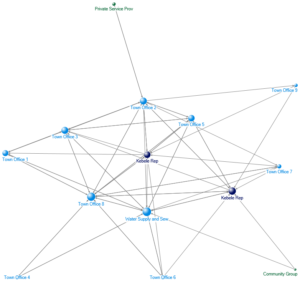Network analysis has become an increasingly popular tool in the international development world as part of an overall trend towards more systems-oriented approaches to program design and evaluation. This sort of analysis can produce a nearly endless number of metrics and statistics on interactions within a network of individuals or organizations, allowing for extensive, in-depth assessments as well as fun, interactive diagrams. But under the USAID Sustainable WASH Systems Learning Partnership , LINC is testing applicability of network analysis to help drive change not only as a research tool, but also through direct integration into an intervention on the ground. The partnership is still in its early days, but has already provided some interesting and surprising lessons.
Under SWS, LINC is working in Ethiopia with IRC, Tetra Tech, and the University of Colorado Boulder to develop and manage learning alliances, locally-led platforms that bring together stakeholders around a given WASH issue to improve collaboration – essentially creating the “software” that will make all of the local WASH “hardware” run effectively and sustainably. One of these local platforms is being set up by SWS in Woliso, a town just a couple of hours outside of Addis Ababa, focused on addressing major issues with sustainable sanitation in urban areas. As part of a suite of baseline systems analyses, LINC conducted a network analysis of interactions among all of the key town sanitation stakeholder organizations, examining how these organizations interact to share information, solve problems, and coordinate activities.
Woliso Sanitation Information Sharing Organizational Network
Rather than just collecting the data and publishing a report, LINC also worked closely with the local learning alliance facilitators to figure out which findings might be most relevant and useful to the local stakeholders in setting up the platform. During the recent learning alliance kick-off, LINC had the opportunity to present these findings back to the stakeholders and support the local facilitators in using the findings to guide the discussion of how best to structure the platform.
This exercise produced some surprises. When designing the tool, LINC anticipated there would be debate about the placement of some organizations in the network, with the analysis revealing “hidden” influencers that would surprise the local stakeholders. In fact, when the findings were presented back to the stakeholders, they fully agreed with the overall conclusions regarding which organizations are more central and which are more peripheral to the sanitation network. Indeed, the network position of one local organization that had surprised both LINC and the local facilitators was quickly explained by the stakeholders as a direct result of the way the local budgeting and reporting process is structured.
“If we didn’t have the network diagram to guide us, we would have started with a focus on each organizations’ formal mandate, and probably just discussed who has more of a mandate when it comes to sanitation”
-Woliso Learning Alliance Facilitator
Although the big “reveal” that LINC had prepared turned out already to be common knowledge, the network analysis presentation proved to be a particularly strong tool for both the facilitators and the participants to anchor their lively discussion of what the learning alliance should look like.
Up to that point, the conversation had been about technical issues in sanitation and the formal mandates that each organization has in the town. Once the network analysis was presented, however, the discussion shifted towards the actual day-to-day collaboration that is, or is not, happening, and the different ways the learning alliance platform could improve the situation. As the local facilitator put it after the meeting, “If we didn’t have the network diagram to guide us, we would have started with a focus on each organizations’ formal mandate, and probably just discussed who has more of a mandate when it comes to sanitation…, it ignited the group thinking, ‘should we really coordinate only through [the official local sanitation manager], or should we have more direct links [with each other]?’”
“Network analysis may have more value in facilitating strategic discussions than in simply sharing specific results.”
The stakeholders continued to refer to the network analysis as they progressed towards establishing the roster of organizations that should form the basis of the learning alliance. Part of LINC’s analysis used an algorithm to identify a core group of organizations with the most significant existing interactions. The stakeholders referred directly to this list as their starting roster. Interestingly, though, they also pointed out some of the organizations that are not in the current “core” group according to the analysis as important organizations to include in the alliance, to increase their integration into sectoral decision-making. This was in some cases a very literal reference to the network diagram: someone would point to a peripheral organization in the diagram while discussing the need to move them into the center of the picture.
These uses show that when it comes to designing and managing multi-stakeholder platforms, network analysis may have more value in facilitating strategic discussions than in simply sharing specific results. When the analysis is done alongside local practitioners and integrated into stakeholder discussions, it can provide a powerful tangible basis for deciding how best to structure a platform and who to include. LINC is excited to continue with this initial work on SWS by conducting a follow-up analysis next year, tracking changes to the network and giving its partners another set of results to help keep the learning alliances vibrant and effective.
About the USAID Sustainable WASH Systems Learning Partnership: LINC is part the SWS consortium, which brings together systems-thinking organizations across contexts at the rural to national level in Ethiopia, Uganda, Kenya, and Cambodia. This effort aims to generate evidence to guide systems-based approaches in WASH.

